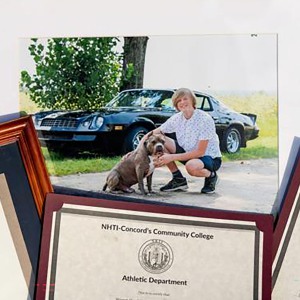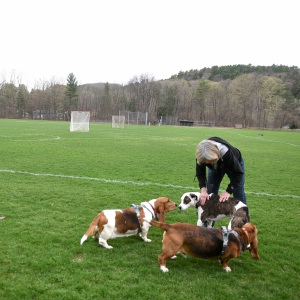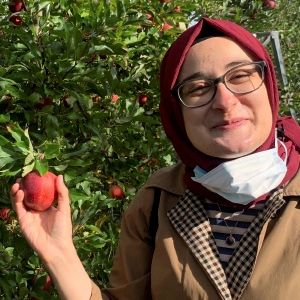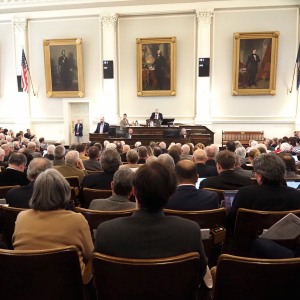A Solitary Walker: Post-election buckthorn therapy
| Published: 11-15-2024 4:15 PM |
The air felt chilly — jacket weather, with the November sun breaking through just enough to show off the green mosses and wood ferns along the path. A couple chickadees, a nuthatch and a downy woodpecker worked the trees above looking for food. A large fresh pile of apple-filled bear poop reminded me not to be tempted to put the bird feeders up until snow cover. Larches splashing yellow here and there across the valley were all that was left of autumn’s fiery paints. We were, as Noah’s song says, in stick season, when the bones of the woods are laid bare.
Wearing my Strafford/South Strafford unity hoodie which has “05070/05072” on the front, and an orange wool beanie, remembering that fall in Vermont accommodates overlapping hunting seasons, I strapped the two little brown dogs into their harnesses with orange scraps tied on and attached their double leash to a belt around my waist. We do not usually go into the woods tied together like this, but this was not a typical day. We were going up to the hills above the river to get lost in some trail therapy and I needed my hands to be free.
I had noticed buckthorn saplings with their speckled opposite stems making a V shape, often with a false thorn in the V, and with buds that list over to one side, as if to say, It’s him, not me. The saplings were working their way down into the forest from the power lines, which are nurseries for introduced species thriving in edges and clear cuts. These plants green up in early spring and stay green well into fall, out-photosynthesizing the plants who migrated back here from refugia in the south as the glaciers melted from New England.
Our native plants are still on their cold-weather clocks. Be careful, go slow, they seem to say, You never know when the ice might come back, as they are outcompeted by the buckthorns, autumn olives, barberries and honeysuckles that are acclimated to milder climes. To add even more insult, the common buckthorn— Rhamnus cathartica has abundant dark purple berries which are not nutritious to birds, mildly toxic to mammals, and, as the epithet says, cathartic, causing the seeds to be widely and immediately dispersed. Our insects, our birds, our mammals thrive alongside our native plants.
The LBDs and I, hooked together, headed up to the trails above the village, rake, clippers and saw somehow attached. We were on a mission to clean off the hiking paths, pull the young buckthorns, saw down the big buckthorns, clip the stubs, and do anything else we could to be helpful and to be too exhausted to feel sad about the election.
I had been thinking about tackling these aggressive non-native shrubs for years now as they slowly invaded this lovely old forest of beech, hemlock, maple and birch — nibbling away at the edges by the power lines and the abandoned hayfield. Hillsides of ramps and blue cohosh, seersucker sedge, spring beauties, hepaticas, Dutchman’s breeches, and even uncommon ginseng and squirrel corn could be lost. A pristine mature forest under threat from an aggressive plant that harms wildlife, and if left to run wild, will leave it impoverished. This work seemed a good place to put my post-election anger and confusion, although the LBDs grew bored and wondered why all this staying in one place. They looked at me, giving their harnesses a little shake, as if there was some mistake (sorry Robert Frost). Much as I felt for them, I knew if I let them off, they would soon be in the next county, baying and chasing after poor fur or feather bearers who were just trying to fatten up for winter.
I cannot do anything to change the minds of the millions who voted differently from me, nor can I yet understand their fierce convictions, but I am powerful with saw and clippers and the old, rusted rake. My late husband, Carl, used to say that disappointment was a terrible thing to waste. I can hear him say to me, “Don’t complain, get out there and do something helpful.”
Micki Colbeck is a naturalist and a writer and chair of the Strafford Conservation Commission. Write to her at mjcolbeck@gmail.com.
Article continues after...
Yesterday's Most Read Articles
 Hundreds of alumni sign letter urging Beilock, Dartmouth to make a stand for academic freedom
Hundreds of alumni sign letter urging Beilock, Dartmouth to make a stand for academic freedom
 ‘A bit Kafkaesque’: Federal judge spars with government lawyer over status of Dartmouth international student
‘A bit Kafkaesque’: Federal judge spars with government lawyer over status of Dartmouth international student
 Woodstock demotes police chief to patrol officer
Woodstock demotes police chief to patrol officer
 Proposed cuts to Medicaid worry Upper Valley health care providers, advocates
Proposed cuts to Medicaid worry Upper Valley health care providers, advocates
 NH 21-year-old dies amid the worst flu season since 2009
NH 21-year-old dies amid the worst flu season since 2009
 Proposed dog ordinance sparks controversy in Norwich
Proposed dog ordinance sparks controversy in Norwich








 Editorial: Vermont judge defends free speech
Editorial: Vermont judge defends free speech  Editorial: Free speech detentions reach into Upper Valley
Editorial: Free speech detentions reach into Upper Valley Editorial: New Hampshire budget shortfall is a crisis of Republican design
Editorial: New Hampshire budget shortfall is a crisis of Republican design Editorial: Time is running out for American democracy
Editorial: Time is running out for American democracy
